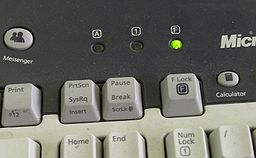
F-Lock
Encyclopedia

Microsoft
Microsoft Corporation is an American public multinational corporation headquartered in Redmond, Washington, USA that develops, manufactures, licenses, and supports a wide range of products and services predominantly related to computing through its various product divisions...
in 2001 toggles the state of the function key
Function key
A function key is a key on a computer or terminal keyboard which can be programmed so as to cause an operating system command interpreter or application program to perform certain actions...
s. When on, keys F1 to F12 behave as standard, with meanings defined by the application being used at the time. When off, new behaviour is used: F5 means "open", F10 means "spell" etc. In early models, the state reverted to off at each reboot or keyboard reset, but later models retained F-Lock state across reboots.
Other keyboard manufacturers (such as Logitech
Logitech
Logitech International S.A. is a global provider of personal peripherals for computers and other digital platforms headquartered in Romanel-sur-Morges, Switzerland. The company develops and markets products like peripheral devices for PCs, including keyboards, mice, microphones, game controllers...
and Viewsonic
ViewSonic
ViewSonic Corporation is a manufacturer and provider of visual technology, specifically CRT monitors, liquid crystal displays, projectors, plasma displays, HDTV technology, and mobile products, including Mini and All-in-One PCs and wireless monitors....
) have also implemented the F-Lock onto their keyboards.
Issues
The introduction of F-Lock was marked by criticism on several points. First, the behaviour was unintuitive: Pressing a key such as F4 by default no longer had its normal meaning, so combinations such as Alt+F4 appeared not to work.Secondly, the choice of secondary function assigned to each key appeared to be arbitrary: whereas F7 was the traditional key for spell-check (used notably by Microsoft itself in its Office products), F7 was assigned the function of "reply", and spell-check was assigned to F10. This caused strong criticism from some commentators.
Pressing F2 in Windows Explorer in attempt to rename a file would instead undo an earlier file operation, with potentially disastrous consequences if the actual effect went silently unnoticed.
Because of such concerns, a number of methods for disabling the F-Lock function appeared on the web.
Many Windows/PC users have found a workaround using Microsoft's Intellitype Pro software, which allows a user to assign keystrokes/macros to the function and accessory keys. For example, assigning a macro {Press
Functions
The new behaviours assigned to the keys are as follows:| Key | New behaviour |
|---|---|
| Help | |
| Undo | |
| Redo | |
| New | |
| Open | |
| Close | |
| Reply | |
| Forward | |
| Send | |
| Spell | |
| Save | |

